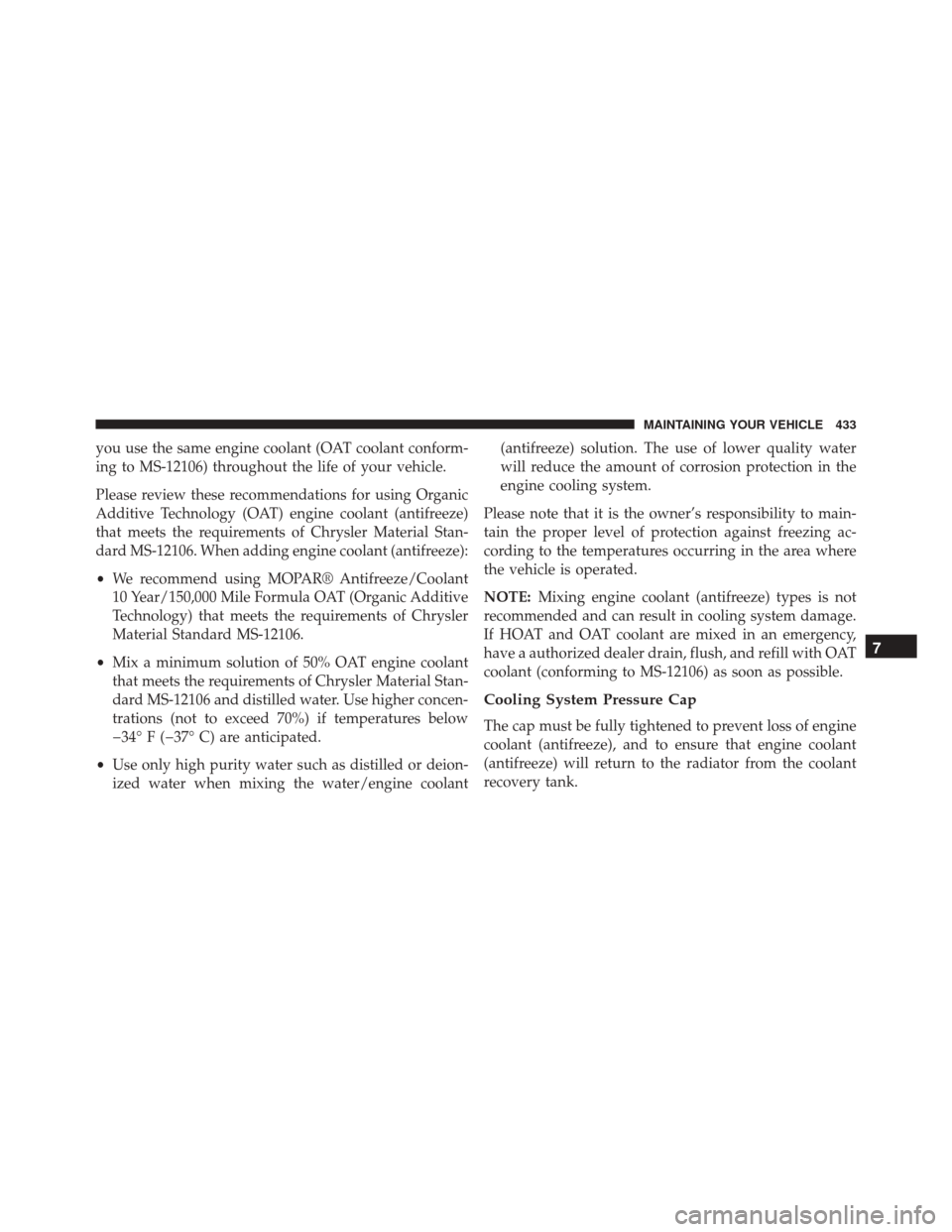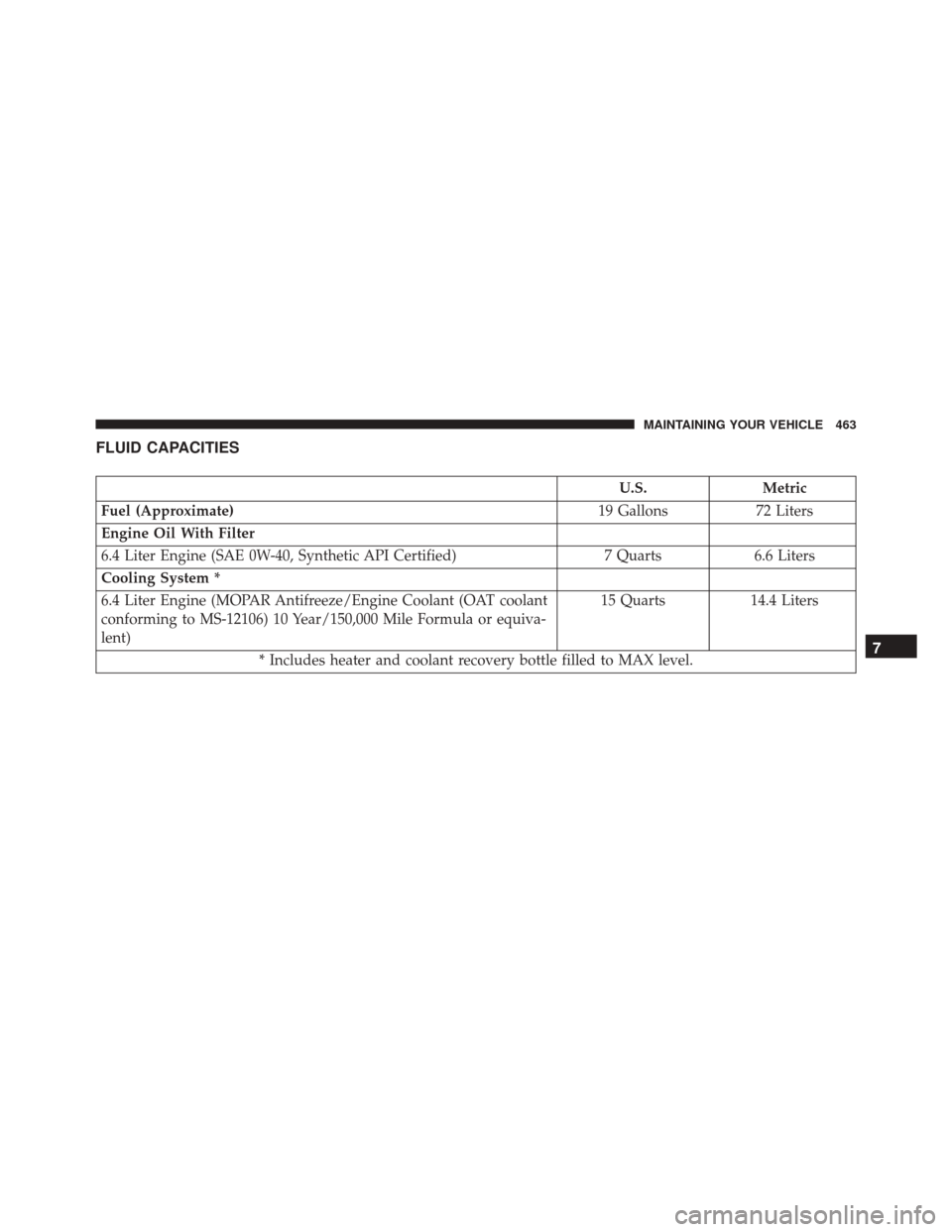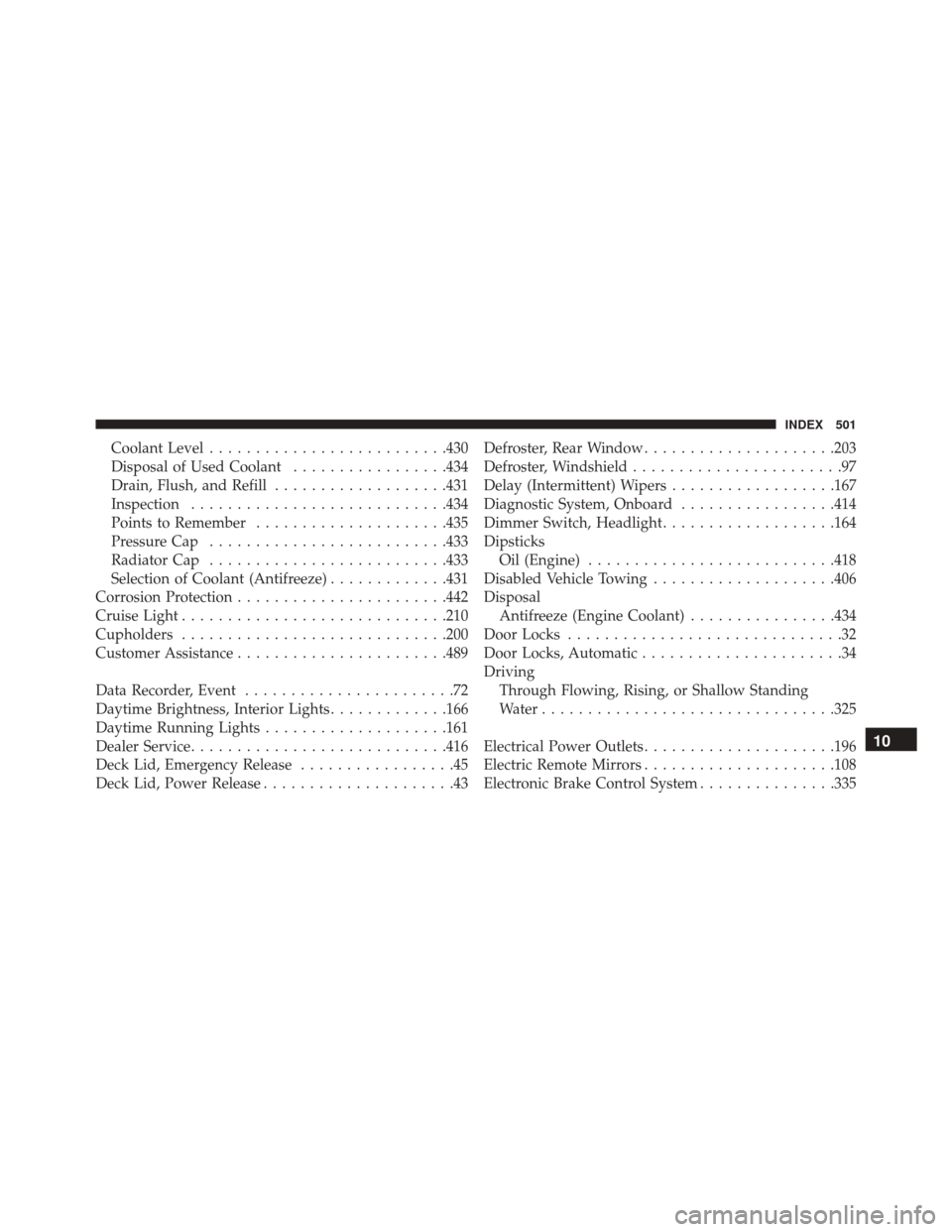2013 DODGE CHALLENGER SRT coolant level
[x] Cancel search: coolant levelPage 435 of 520

you use the same engine coolant (OAT coolant conform-
ing to MS-12106) throughout the life of your vehicle.
Please review these recommendations for using Organic
Additive Technology (OAT) engine coolant (antifreeze)
that meets the requirements of Chrysler Material Stan-
dard MS-12106. When adding engine coolant (antifreeze):
•We recommend using MOPAR® Antifreeze/Coolant
10 Year/150,000 Mile Formula OAT (Organic Additive
Technology) that meets the requirements of Chrysler
Material Standard MS-12106.
• Mix a minimum solution of 50% OAT engine coolant
that meets the requirements of Chrysler Material Stan-
dard MS-12106 and distilled water. Use higher concen-
trations (not to exceed 70%) if temperatures below
�34° F (�37° C) are anticipated.
• Use only high purity water such as distilled or deion-
ized water when mixing the water/engine coolant (antifreeze) solution. The use of lower quality water
will reduce the amount of corrosion protection in the
engine cooling system.
Please note that it is the owner’s responsibility to main-
tain the proper level of protection against freezing ac-
cording to the temperatures occurring in the area where
the vehicle is operated.
NOTE: Mixing engine coolant (antifreeze) types is not
recommended and can result in cooling system damage.
If HOAT and OAT coolant are mixed in an emergency,
have a authorized dealer drain, flush, and refill with OAT
coolant (conforming to MS-12106) as soon as possible.
Cooling System Pressure Cap
The cap must be fully tightened to prevent loss of engine
coolant (antifreeze), and to ensure that engine coolant
(antifreeze) will return to the radiator from the coolant
recovery tank.
7
MAINTAINING YOUR VEHICLE 433
Page 436 of 520

The cap should be inspected and cleaned if there is any
accumulation of foreign material on the sealing surfaces.
WARNING!
•The warning words “DO NOT OPEN HOT” on the
cooling system pressure cap are a safety precaution.
Never add engine coolant (antifreeze) when the
engine is overheated. Do not loosen or remove the
cap to cool an overheated engine. Heat causes
pressure to build up in the cooling system. To
prevent scalding or injury, do not remove the
pressure cap while the system is hot or under
pressure.
• Do not use a pressure cap other than the one
specified for your vehicle. Personal injury or en-
gine damage may result.
Disposal Of Used Engine Coolant
Used ethylene glycol-based engine coolant (antifreeze) is
a regulated substance requiring proper disposal. Check
with your local authorities to determine the disposal
rules for your community. To prevent ingestion by ani-
mals or children, do not store ethylene glycol-based
engine coolant in open containers or allow it to remain in
puddles on the ground. If ingested by a child or pet, seek
emergency assistance immediately. Clean up any ground
spills immediately.
Coolant Level
The coolant bottle provides a quick visual method for
determining that the coolant level is adequate. With the
engine OFF and cold, the level of the coolant in the bottle
should be between the ranges indicated on the bottle.
The radiator normally remains completely full, so there is
no need to remove the radiator cap unless checking for
coolant freeze point or replacing coolant. Advise your
434 MAINTAINING YOUR VEHICLE
Page 437 of 520

service attendant of this. As long as the engine operating
temperature is satisfactory, the coolant bottle need only
be checked once a month.
When additional coolant is needed to maintain the
proper level, it should be added to the coolant bottle. Do
not overfill.
Points To Remember
NOTE:When the vehicle is stopped after a few miles/
kilometers of operation, you may observe vapor coming
from the front of the engine compartment. This is nor-
mally a result of moisture from rain, snow, or high
humidity accumulating on the radiator and being vapor-
ized when the thermostat opens, allowing hot engine
coolant (antifreeze) to enter the radiator.
If an examination of your engine compartment shows no
evidence of radiator or hose leaks, the vehicle may be
safely driven. The vapor will soon dissipate. •
Do not overfill the coolant expansion bottle.
• Check the coolant freeze point in the radiator and in
the coolant expansion bottle. If engine coolant (anti-
freeze) needs to be added, the contents of the coolant
expansion bottle must also be protected against freez-
ing.
• If frequent engine coolant (antifreeze) additions are
required, the cooling system should be pressure tested
for leaks.
• Maintain engine coolant (antifreeze) concentration at a
minimum of 50% OAT coolant (conforming to MS-
12106) and distilled water for proper corrosion protec-
tion of your engine which contains aluminum compo-
nents.
• Make sure that the coolant expansion bottle overflow
hoses are not kinked or obstructed.
7
MAINTAINING YOUR VEHICLE 435
Page 438 of 520

•Keep the front of the radiator clean. If your vehicle is
equipped with air conditioning, keep the front of the
condenser clean.
• Do not change the thermostat for Summer or Winter
operation. If replacement is ever necessary, install
ONLY the correct type thermostat. Other designs may
result in unsatisfactory engine coolant (antifreeze)
performance, poor gas mileage, and increased emis-
sions.
Brake System
In order to assure brake system performance, all brake
system components should be inspected periodically.
Refer to the “Maintenance Schedule” for the proper
maintenance intervals.
WARNING!
Riding the brakes can lead to brake failure and
possibly a collision. Driving with your foot resting or
riding on the brake pedal can result in abnormally
high brake temperatures, excessive lining wear, and
possible brake damage. You would not have your full
braking capacity in an emergency.
Master Cylinder – Brake Fluid Level Check
Check the fluid level in the master cylinder immediately
if the “Brake Warning Light” indicates system failure.
Check the fluid level in the master cylinder when per-
forming underhood services.
436 MAINTAINING YOUR VEHICLE
Page 465 of 520

FLUID CAPACITIES
U.S.Metric
Fuel (Approximate) 19 Gallons72 Liters
Engine Oil With Filter
6.4 Liter Engine (SAE 0W-40, Synthetic API Certified) 7 Quarts6.6 Liters
Cooling System *
6.4 Liter Engine (MOPAR Antifreeze/Engine Coolant (OAT coolant
conforming to MS-12106) 10 Year/150,000 Mile Formula or equiva-
lent) 15 Quarts
14.4 Liters
* Includes heater and coolant recovery bottle filled to MAX level.
7
MAINTAINING YOUR VEHICLE 463
Page 471 of 520

referring to the steps described under “Electronic Vehicle
Information Center (EVIC)/Oil Change Required” in
“Understanding Your Instrument Panel” for further in-
formation.
At Each Stop For Fuel
•Check the engine oil level. Refer to “Maintenance
Procedures/Engine Oil” in “Maintaining Your Ve-
hicle” for further information.
• Check the windshield washer solvent and add if
required.
Once A Month
• Check tire pressure and look for unusual wear or
damage.
• Inspect the battery, and clean and tighten the terminals
as required. •
Check the fluid levels of the coolant reservoir, brake
master cylinder, and power steering, and add as
needed.
• Check all lights and other electrical items for correct
operation.
At Each Oil Change
• Change the engine oil filter.
• Inspect the brake hoses and lines.
CAUTION!
Failure to perform the required maintenance items
may result in damage to the vehicle.
Required Maintenance Intervals
Refer to the Maintenance Schedules on the following
pages for the required maintenance intervals.
8
MAINTENANCE SCHEDULES 469
Page 503 of 520

Coolant Level......................... .430
Disposal of Used Coolant .................434
Drain, Flush, and Refill ...................431
Inspection ........................... .434
Points to Remember .....................435
Pressure Cap ......................... .433
Radiator Cap ......................... .433
Selection of Coolant (Antifreeze) .............431
Corrosion Protection ...................... .442
Cruise Light ............................ .210
Cupholders ............................ .200
Customer Assistance ...................... .489
Data Recorder, Event .......................72
Daytime Brightness, Interior Lights .............166
Daytime Running Lights ....................161
Dealer Service ........................... .416
Deck Lid, Emergency Release .................45
Deck Lid, Power Release .....................43 Defroster, Rear Window
.....................203
Defroster, Windshield .......................97
Delay (Intermittent) Wipers ..................167
Diagnostic System, Onboard .................414
Dimmer Switch, Headlight ...................164
Dipsticks Oil (Engine) .......................... .418
Disabled Vehicle Towing ....................406
Disposal Antifreeze (Engine Coolant) ................434
Door Locks ..............................32
Door Locks, Automatic ......................34
Driving Through Flowing, Rising, or Shallow Standing
Water ............................... .325
Electrical Power Outlets .....................196
Electric Remote Mirrors .....................108
Electronic Brake Control System ...............335
10
INDEX 501
Page 504 of 520

Anti-Lock Brake System..................335
Electronic Power Distribution Center (Fuses) ......451
Electronic Speed Control (Cruise Control) ........171
Electronic Stability Control (ESC) ..............339
Electronic Throttle Control Warning Light ........211
Electronic Vehicle Information Center (EVIC) ......221
Emergency Deck Lid Release ..................45
Emergency, In Case of Freeing Vehicle When Stuck ................403
Hazard Warning Flasher ..................388
Jump Starting ......................... .399
Overheating .......................... .388
Towing ............................. .406
Emergency Trunk Release ....................45
Emission Control System Maintenance ..........415
Engine ................................ .413
Air Cleaner .......................... .420
Block Heater ......................... .300
Break-In Recommendations .................93 Checking Oil Level
..................... .418
Compartment ......................... .413
Coolant (Antifreeze) .....................430
Cooling ............................. .430
Exhaust Gas Caution .....................95
Fails to Start .......................... .297
Flooded, Starting ...................... .297
Fuel Requirements ..................... .375
Jump Starting ......................... .399
Oil................................. .418
Oil Change Interval ..................... .418
Oil Filler Cap ......................... .419
Oil Selection .......................... .419
Oil Synthetic ......................... .419
Overheating .......................... .388
Starting ............................. .291
Temperature Gauge ......................211
Engine Oil Viscosity ...................... .419
Enhanced
Accident Response Feature ............68
502 INDEX